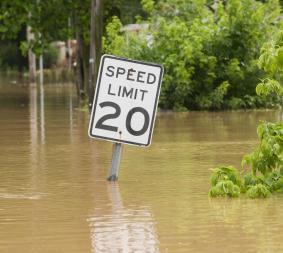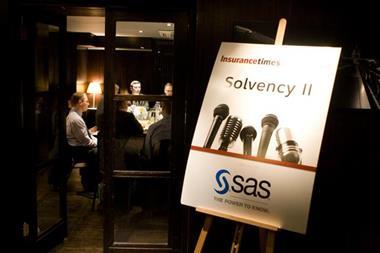Claims experts at a recent roundtable in the City of London tackled the minefield of issues surrounding crisis management
Heavy hitters from the claims sector came together at Insurance Times’s latest roundtable in the City of London to talk about customer care in a crisis. Chaired by Insurance Times executive editor Ellen Bennett and held in association with Crawford & Company, the event took place in the Dome Room, Cornhill, on a sun-soaked day in the capital.
During the discussion, the panel, which included representatives from supply chain firms, focused their attention on experiences from the 2007 floods and, more recently, those in Cumbria. Some of the major issues that arose included communication within the industry, technology and fraud.
The debate kicked off with a discussion on whether the industry was getting customer care right. Crawford client services director Richard Turner said the industry had already taken a lot on board from the 2007 floods.
“Crawford instigated an extensive project-managed approach to identifying and applying those learnings,” he says. “They were applied in Cockermouth in November and since then, as we’ve handled those claims through to conclusion or some that are still ongoing.
“We’ve seen the benefits of that, but I don’t think we should be complacent. We’ve already had sessions with key clients to identify the learnings from that event, so we must continue to evolve and improve the service for customers. There is absolutely work still to be done.”
AXA claims director David Williams agreed.
“If you look back over the past few years, we’ve made tremendous progress,” he said. “We’ve had some nice little weather events to help us practise.
“I think 2007 went staggeringly well for us, bearing in mind the size of it and the unexpected timing, because a lot of us gear up for bad weather at different times of the year. I think there’s still a lot to be done.”
Dunkirk spirit
Williams said it was fortunate for the industry that customers affected by the 2007 floods had shown a “Dunkirk spirit”.
“They didn’t expect things to be done as quickly as they would have been done in a non-event scenario,” he said. “I think that’s fair and reasonable, but it came as a surprise. I don’t know whether we could always guarantee to get that sort of latitude.
“Customer demand is increasing and we still miss opportunities to excel. We don't co-operate enough as an industry – for obvious reasons sometimes – but we do miss opportunities that would improve the overall customer experience.”
Carter Construction divisional director Steve Whittle lives in Tewkesbury, an area badly affected by flooding. Recalling his experiences, he said: “We have an office in Tewkesbury and we had a vast number of claims just appear through our fax machine and email system. Generally, it was handled very well, but I take Richard’s point that there were learning points for everybody in that process.
“We didn’t want to take on too much work at any one time. We restricted the amount and closed our order book after about three weeks – we had about £3m worth of work. That was fantastic.
“But there were certain processes, and there were people in the supply chain whose eyes were bigger than their belly, to put it bluntly, and that caused immense problems. And there was unskilled labour thrown in, which also caused problems.
“But, taking a holistic view, the vast majority of people in Tewkesbury were back into their homes within nine months, and it didn’t look like some sort of tent city any longer.”
Communication in a crisis
The debate turned to communication between firms during a crisis. Belfor key accounts team manager Sam Dawson said communication often becomes strained and can develop into a big issue. The idea of having one communication centre for all related firms was suggested.
Another issue that causes confusion, agreed the panel, is when different insurers have different processes for handling claims.
Dawson sided with the loss adjustors. “I feel really sorry for the adjustors,” he said. “They’re bombarded with claims and probably one of the biggest challenges they face is that all their clients do everything differently with different insurers.
“The adjustor’s got umpteen different cases to deal with for different brands. We work with insurers, and they have different processes and procedures and delegated authorities on individual brands, let alone different clients.
“It’s an almost thankless task. There is definitely an argument to simplify the overall process.”
Turner gave a guarded response to the idea. “The claims process is different for just about every insurer. It might be minor differences. They are tailored to the individual client and they want to retain their competitive advantage in times of surge. I think you wouldn’t want to deviate.
“If you go to the USA and look at hurricane response, it’s a single process, it’s subcontracted and you get all this resource coming from different parts of the world. They largely work with one process, one set of reporting, and you can see the advantages of that. But our market is very sophisticated and it would be difficult to move fully in that direction.”
The group also discussed the thorny issues surrounding fraud. It was agreed that opportunistic fraud was one of the biggest problems today.
Williams said the industry needed to be alert. “The best way to reduce the risk of somebody exaggerating or building a claim for negotiation purposes is to set their expectations and include that they are going to get a fair settlement and deal with it rapidly.
“One thing we’ve noticed is that the longer a claim remains outstanding, the bigger it seems to get. But if you set expectations – making clear that [the client is] going to get a fair settlement and putting them at ease – and then deal with it rapidly, that’s the best deterrent.” IT






































No comments yet